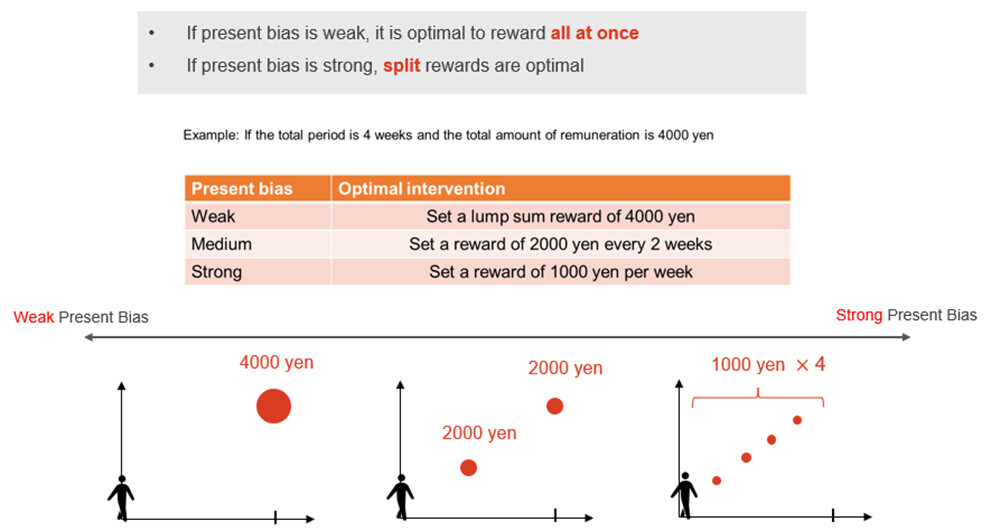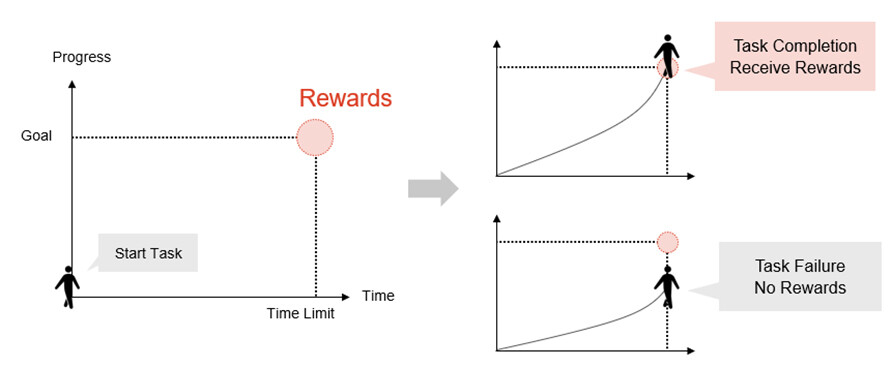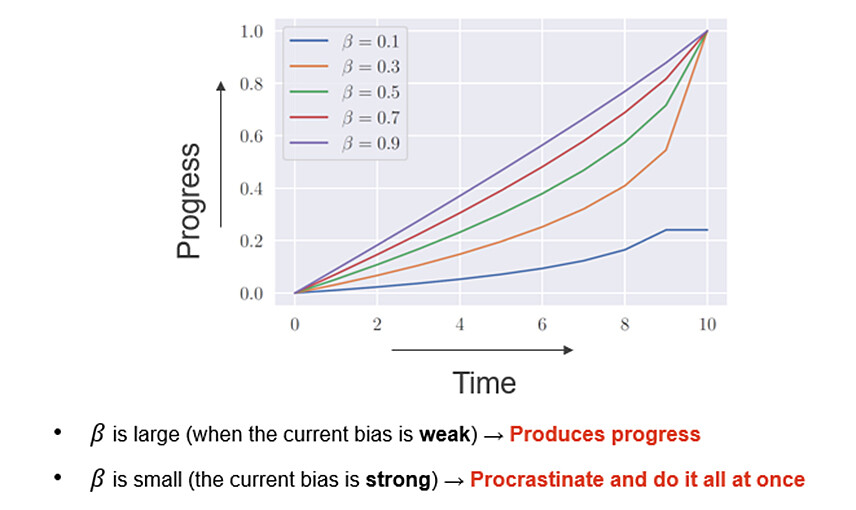Microsoft ends support for Internet Explorer on June 16, 2022.
We recommend using one of the browsers listed below.
- Microsoft Edge(Latest version)
- Mozilla Firefox(Latest version)
- Google Chrome(Latest version)
- Apple Safari(Latest version)
Please contact your browser provider for download and installation instructions.
April 19, 2024
NTT Corporation
Mathematical model to analyze human behavior under the influence of present biases and derive optimal interventions
Helps individuals achieve their goals successfully without the computational cost of simulation experiments
Tokyo - April 19, 2024 - NTT Corporation (NTT) has developed a new mathematical model that can analyze the long-term goal attainment behavior of people under the influence of present bias, a human cognitive bias that overestimates immediate gains and losses, and then derive optimal interventions to support goal attainment. By applying appropriate interventions based on the strength of an individual's present bias derived from this model, it is possible to support the success of an individual's goal attainment behaviors related to health and education. These results were presented at The 38th AAAI Conference on Artificial Intelligence (AAAI-24)*, the premier international conference in the field of AI, held in Vancouver, Canada, from February 20 to 27, 2024. This paper was selected as an oral presentation, which is 1% of all submissions.
*URL:https://aaai.org/aaai-conference/
1. Background of the study
Humans have a cognitive bias1 called present bias2 that overestimates immediate gains and losses. The strength of the present bias varies from person to person. People who have strong present bias are said to be more likely to succumb to the temptations in front of them and to procrastinate during difficulties. Strong present bias is known to inhibit the success of long-term goal-attaining behaviors. An example of long-term goal attainment behavior is a walking program that sets a monthly step goal for health and aims to achieve it. Understanding how present bias affects human behavior and providing appropriate interventions according to the strength of an individual's present bias has been studied as an important topic in the fields of computer science and behavioral economics. For example, interventions include setting and offering incentives based on progress in a long-term walking program.
Existing research has proposed a method that uses a graph consisting of vertices and edges to represent human goal attainment behavior under the influence of present biases and analyze the behavior. The problem with this approach is that it requires running computationally expensive simulation experiments to see the actual behavior of humans. Furthermore, it was known that seeking optimal interventions to support goal attainment behavior is difficult and cannot be done in a realistic amount of computing time.
2. Results of the research
We have developed a new mathematical model to analyze human behavior under present bias and to derive optimal interventions. This model has the advantage of being able to mathematically write down human behavior under present bias in a closed form3 and analyze human behavior without having to run simulations.
Furthermore, we have shown that this model can be used to solve difficult intervention optimization problems in a realistic time. As an example of an optimal intervention, we have mathematically shown that it is optimal to give rewards all at once for people with weak present biases, and to divide rewards into segments and give them frequently to those with strong present biases. This result can be interpreted that the behavior of people with strong present biases is subject to immediate gains and losses, so it is effective to keep them aware of the immediate goal with intermediate rewards. Applying the derived optimal interventions to real-world individual goal attainment behaviors, such as health and education, can significantly improve goal attainment.
 Figure 1 Example of Optimal Intervention
Figure 1 Example of Optimal Intervention
3. Key points of the technology
- Focus on "Progress-accumulating tasks"
In this study, we focused on what we call "Progress-accumulating tasks" among goal attainment tasks. Progress-accumulating tasks are tasks that aim to achieve "progress target" by accumulating numerical values called "progress" within a given time limit, and rewarding achievement. Such tasks appear in the real world daily. For example, walking 10 hours a week for health, completing a graduation thesis in 6 months, and so on. By incorporating the structure specific to progress-accumulating tasks as constraints and using mathematical techniques, we have succeeded in writing down human behavior in a mathematically closed-form expression.
 Figure 2 Examples of Progress-accumulating Tasks
Figure 2 Examples of Progress-accumulating Tasks
 Figure 3 Results of Calculating Progress-accumulating Tasks Using a Mathematical Model
Figure 3 Results of Calculating Progress-accumulating Tasks Using a Mathematical Model
*Different progress is reproduced depending on the strength of the present bias (β)
- Use of mathematical optimization techniques
We used a technique called mathematical optimization to find the optimal intervention in the constructed model. Mathematical optimization is a technical field with a long history of efficiently finding solutions that satisfy constraints that minimize or maximize the objective function4. By utilizing various techniques used in this mathematical optimization technique, we succeeded in constructing an algorithm that rapidly finds optimal intervention in various problem settings (e.g., optimal goal-setting problem, optimal incentive design problem, etc.).
4. Outlook
The result of this study is theoretical at this stage, and we will continue to validate the effectiveness of the model using data on real-world goal achievement tasks. Human beings have various cognitive biases in addition to their present biases, and to take these into account, we aim to incorporate scientific knowledge on human behavior such as social science, psychology, and behavioral economics into mathematical models that mimic more human behaviors. We also aim to incorporate technology into systems that support decisions related to the essential values of society in areas such as education and assets, as well as healthcare.
1Present bias
The tendency to overestimate immediate gains over long-term gains. One example of the phenomenon of present bias is that people trying to lose weight fail to diet because they prioritize the feast in front of them over achieving their long-term health.
2Cognitive bias
A psychological phenomenon in which people unconsciously make irrational judgments. Humans are thought to be under the influence of various cognitive biases. Typical examples include confirmation bias, in which people pay attention to information that supports their beliefs and hypotheses and ignore other information; availability heuristics, in which people overestimate experiences and information that are easy for them to recall; and loss aversion, in which people are overly afraid of taking a loss.
3Mathematically write down human behavior under present bias in a closed form
To describe the behavior of an object using a finite number of well-known functions. A closed-form object can be computed directly, and its properties can be examined without iterative calculations, approximations, or simulations.
4Objective function
A value used to evaluate the goodness of a solution in a mathematical optimization problem. Mathematical optimization techniques find high-value strategies by looking for solutions that maximize or minimize the objective function. For examples, if the objective function is time required, the transportation route that minimizes the time required will be found, and if the objective function is fee, the transportation route that minimizes the fee will be found.
About NTT
NTT contributes to a sustainable society through the power of innovation. We are a leading global technology company providing services to consumers and businesses as a mobile operator, infrastructure, networks, applications, and consulting provider. Our offerings include digital business consulting, managed application services, workplace and cloud solutions, data center and edge computing, all supported by our deep global industry expertise. We are over $97B in revenue and 330,000 employees, with $3.6B in annual R&D investments. Our operations span across 80+ countries and regions, allowing us to serve clients in over 190 of them. We serve over 75% of Fortune Global 100 companies, thousands of other enterprise and government clients and millions of consumers.
Media contact
NTT Service Innovation Laboratory Group
Public Relations
nttrd-pr@ml.ntt.com
Information is current as of the date of issue of the individual press release.
Please be advised that information may be outdated after that point.
NTT STORY
WEB media that thinks about the future with NTT










